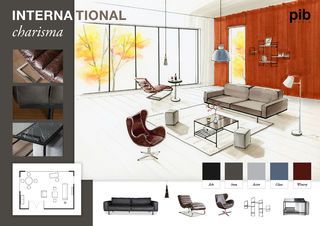assistant
French Days
10% off everything

INTERNATIONAL STYLE
International Style furniture was most recognised as a modern style from the 30s through 50s, laying important grounds for the post-war modernism in mid-century design (50s - early 60s)
Modernism
Le Corbusier (Charles-Édouard Jeanneret-Gris) once said: "Space and light and order. Those are things that men need just as much as they need bread or a place to sleep." This quote by the famous Swiss architect, decorator, artist and urbanist, summarizes the most important characteristics of International Style, the prominent architectural movement of the 20th century, of which he himself was one of the pioneers together with Walter Gropius and Mies van der Rohe. The style emphasizes the volume of space using the structure and by allowing light to flood in through curtain-wall glass windows, it creates an illusion of the blurred line between the interior and exterior spaces. Using a specific, almost fixed principal set of rules, it prized itself in the capacity to create order and universal unity. It also became the dominant style of 20th-century architecture for institutional and commercial buildings, and even replaced the traditional historical styles for schools and churches.
Often dubbed with 'modern architecture' or 'modernism', the actual term of International Style was coined in 1932 by the young historian Henry-Russell Hitchcock and architect Philip Johnson in an exhibition organized by the Museum of Modern Art (MoMA) in New York City featuring the works of various architects in Europe and some Americans whose style could be grouped under the umbrella of a new direction towards modernism, shedding all old values with no references to any precedent periods.

Beginning of International Style - L'Unité d'habitation in Marseille

Inside Edward J. Flavin House - Richard Neutra Architect 1957
“The home should be the treasure chest of living.”
Le Corbusier
A brief history
After the first World War, the Western society steered steadily towards the industrialized and mechanized direction. These factors demanded a more utilitarian, honest and economical approach for architecture that relied hard and fast on the new industrial technologies for cheaper, easier and quicker to mass produce materials. In Europe, the modern movement in architecture had been called Functionalism or Neue Sachlichkeit (New Objectivity), L'Esprit Nouveau (New Spirit), or simply Modernism and was very much concerned with the coming together of a new architectural form and social reform, creating a more open and transparent society. Later commonly known as "International Style", named by Hitchcock and Johnson, it had developed in 1920s Western Europe, shaped by the activities of the Dutch De Stijl movement, Le Corbusier, and the Deutscher Werkbund and the Bauhaus.
After World War II, since many destroyed cities needed reconstructing fast and cheaply, the International Style was a very suitable choice as it offered the possibility to have many floors within the same building, using mass-produced materials with new construction technologies and remarkably economical advantages, many governments opted for this architectural type to rebuild their cities. In the 50s and 60s, the International Style had been perfected and became the 'unofficial' national architecture in the US and Canada.
In 1970s, the International Style was so dominant that it lost its universal charm. As the saying went: "You got off an airplane in the 1970s, and you didn't know where you were." Denuded facades, lack of privacy, deprivation of beauty and individuality, it was also accused of obstructing a sense of community and solidarity, deepening the disparity between people living inside boxes of glass. By the end of the decade, modernism and the International Style were finished and postmodernism took hold.

Seagram Building, New York, by Mies Van der Rohe
In this universe

With a fresh air of modern space and light, the international style is relevant and alluring as it has always been.
International Charisma - Styling board
INTERNATIONAL STYLE - 04-Aug-2021
Associated Products
Pioneer practitioners of the International Style included a group of brilliant and original architects in the 1920s who went on to achieve enormous influence in their field:
- Walter Gropius (1883-1969) in Germany
- J.J.P. Oud (1890-1963) in Holland
- Le Corbusier (1887-1965) in France
- Richard Neutra (1892-1970), Ludwig Mies van der Rohe (1886- 1969), and Philip Johnson (1906-2005) in the United States
Principles of International Style
In their catalogue 'Modern Architecture: International Exhibition' and the book 'The International Style: Architecture Since 1922' written for the exhibition, the Hitchcock and Johnson identified the style's three principles:
- The expression of volume rather than mass
- The regularity arising from standardized elements with an emphasis on balance rather than preconceived symmetry
- The focus on the proportions and materials that excludes arbitrarily applied ornament
The most common characteristics of International Style buildings are: :
- Rectilinear forms
- Light
- Plain decorated surfaces, devoid of applied ornamentation
- Open, even fluid, interior spaces
- Machine aesthetics
- Acceptance of industrialized mass-production techniques
- Adoption of glass, steel and concrete as preferred materials
- Use of cantilever construction
- Transparency of buildings and construction, referred to as the honest expression of structure
International Style industrial design was under the strong influence of the Bauhaus, le Corbusier, and the De Stijl and stayed true to their honest, economical, and utilitarian elements. In fact, most of the furniture featured in the building of this style during their heydays were created by masters of these schools. Gradually, an expanded International Style version of modern industrial design, known generally as "good design" gained broad acceptance in the later 1930s and after the end of WWII, incorporating standards of balance among individual expression, restraint, and practicality. MoMA by then advocated a new principle for industrial design based on the suitability to the purpose, material, and process of manufacturing, all of these were expressed in its Machine Art Exhibition (1934) and embodied in the household products chosen for a series of traveling exhibits.

Ludwig Mies van der Rohe, one of the three pioneering architects that pushed forward the universality and practicality of International Style





















